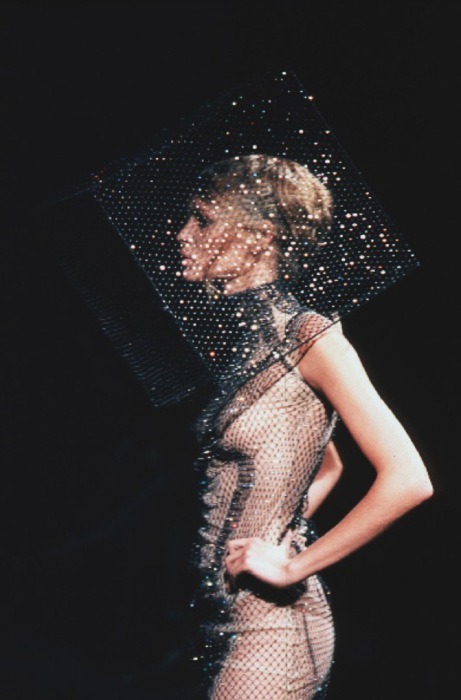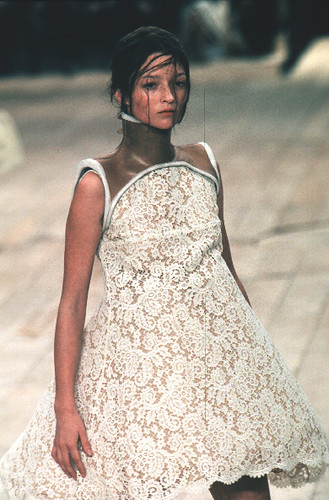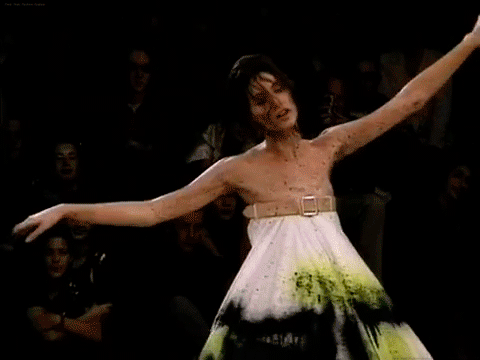After revisiting the past with his ‘Joan’
collection, McQueen moved swiftly towards the future with his next collection,
entitled No. 13 (see the full thing here). The show was one of his most
expensive to date, staged on a sprawling runway which featured revolving
platforms built into the floor, as well as two ominous-looking automatic paint
machines which took centre stage. Taking the codes of the McQueen aesthetic and
reinventing them appeared to be the designer’s main prerogative – there were
plenty of looks which were pulled from the archive and reimagined, bringing
them firmly into the future.
The ‘future’ element of the aesthetic came
primarily down to fabric choice. Metallic silver was ubiquitous throughout much
of the collection, and McQueen also experimented with what appeared to be
several mirrorballs that had been pulled apart and fashioned into a halterneck
bodice which jutted forward dramatically, barely covering the model beneath it.
The classic full-length tux jacket was recreated in reflective silver material
and covered in thick black pinstripes, whereas the chainmail dress from Joan (a
short gown with a plunging backline) saw its silhouette replicated exactly in
the same futuristic fabric.
Soon after, the mood began to toughen somewhat
as necklines crept higher and higher, engorging the throats of the models with
tough, organic materials such as leather and raffia. Silhouettes became less
delicate and more aggressive – dresses were pintucked at the waist so that the
fabric jutted out in exaggerated pleats, whereas several dresses had such
exaggerated proportions that the model would be literally untouchable by
anybody within a 3 foot radius. Two of the most extreme examples of these
proportions were revealed as the lights dimmed and rose again to reveal two
models on revolving platforms wearing dresses whose skirts were made from wood –
resembling a crinoline in terms of volume, the models revolved wordlessly
appearing trapped by their garments.
Arguably the show’s most famous moment came courtesy of handicapped athlete Aimee Mullins walking the runway in a pair of exquisite prosthetic legs, carved from solid wood and teamed with a chiffon skirt and a leather corset that more closely resembled a torture device than an actual garment. The model herself described how her “neck was secured in almost this neckbrace position – I couldn’t look down”, as well as the fact that there was “almost no give in the ankles” of the legs, meaning that even walking the runway was a daunting task. The liberation of featuring a handicapped model was a beautiful concept – even though the models were trapped by their garments, they remained poised and looked elegant. This in itself seems almost like a commentary on McQueen’s resilience in the face of media critique – the man is constantly ostracised for his controversial concepts yet has managed to become one of the world’ most recognised designers.
Finally, the show came to a typically jaw-dropping climax with the iconic appearance of former ballerina Shalom Harrow. Stumbling onto the runway looking dazed and confused, she positioned herself in between the two mechanical paint machines dressed in an enormous white chiffon gown strapped down at the chest with a thick leather belt. As the platform began to revolve, the paint guns whirred into action and defaced the dress with a multitude of hues, the lights began to flash manically as the cameras of the fashion press clicked rapidly to capture the moment. There has been debate about what exactly the finale was meant to represent – some claim that the crescendo was a commentary on technology’s destruction of nature. Others rightly argue that the finale was just another example of spectacle that will go down in history as one of McQueen’s best.
Arguably the show’s most famous moment came courtesy of handicapped athlete Aimee Mullins walking the runway in a pair of exquisite prosthetic legs, carved from solid wood and teamed with a chiffon skirt and a leather corset that more closely resembled a torture device than an actual garment. The model herself described how her “neck was secured in almost this neckbrace position – I couldn’t look down”, as well as the fact that there was “almost no give in the ankles” of the legs, meaning that even walking the runway was a daunting task. The liberation of featuring a handicapped model was a beautiful concept – even though the models were trapped by their garments, they remained poised and looked elegant. This in itself seems almost like a commentary on McQueen’s resilience in the face of media critique – the man is constantly ostracised for his controversial concepts yet has managed to become one of the world’ most recognised designers.
Finally, the show came to a typically jaw-dropping climax with the iconic appearance of former ballerina Shalom Harrow. Stumbling onto the runway looking dazed and confused, she positioned herself in between the two mechanical paint machines dressed in an enormous white chiffon gown strapped down at the chest with a thick leather belt. As the platform began to revolve, the paint guns whirred into action and defaced the dress with a multitude of hues, the lights began to flash manically as the cameras of the fashion press clicked rapidly to capture the moment. There has been debate about what exactly the finale was meant to represent – some claim that the crescendo was a commentary on technology’s destruction of nature. Others rightly argue that the finale was just another example of spectacle that will go down in history as one of McQueen’s best.






No comments:
Post a Comment